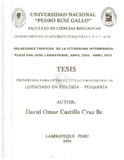Por favor, use este identificador para citar o enlazar este ítem:
https://hdl.handle.net/20.500.12958/3173Registro completo de metadatos
| Campo DC | Valor | Lengua/Idioma |
|---|---|---|
| dc.contributor.author | Castillo Cruz, David | - |
| dc.date.accessioned | 2018-03-27T19:48:44Z | - |
| dc.date.available | 2018-03-27T19:48:44Z | - |
| dc.date.issued | 2004 | - |
| dc.identifier.uri | https://hdl.handle.net/20.500.12958/3173 | - |
| dc.description | Tesis (Lic. Biología - Pesquera).- Universidad Nacional Pedro Ruiz Gallo. Facultad de Ciencias Biológicas. | es_ES |
| dc.description.abstract | Las relaciones tróficas o alimentarias son un aspecto del comportamiento de la ictiofauna intermareal que es afectado por cualquier fenómeno natural o antropogénico dado las condiciones cambiantes y la vulnerabilidad del medio donde estas viven. Con el propósito de determinar cuáles son los ítems que conforman la dieta y las relaciones tróficas de la ictiofauna intermareal y poder construir una posible red trófica; se realizaron muestreos mensuales utilizando una red chinchorro de nylon polifilamento de 60 metros de longitud y un tamaño de malla del"; estos muestreos tuvieron lugar en la zona intermareal al norte de la playa San José (Lambayeque, Perú) desde abril del 2002 abril2003. Se determinó que la dieta de las especies de la íctiofauna está formada principalmente por ítems pertenecientes a grupos como: crustáceos, moluscos, peces y algas; y que entre dichas especies se presentan dos tipos de alimentación herbívoros y carnívoros; las relaciones tráficos fueron dos predador- presa y competencia; estableciendo que la red trófica en el área de estudio está formada por tres niveles tróficos | es_ES |
| dc.description.abstract | ABSTRACT: The trophic or nourishing relations are an aspect of the behavior of the intertidal fishfauna that is affected by any natural or anthropogenic phenomenon given the changing conditions and the vulnerability of the environment where these live. In order to determine the items that conform the trophic diet and relations of the intertidal fishfauna and to be able to establish a possible trophic system; monthly samp!ings were made using a small poly filament-nylon chinchorro net of 60 rneters long and a mesh of 1"; these sarnplings took place in the interiidal zone in the north of the San Jose beach {lambayeque, Peru) from April 2002 to April2003. lt was determined that the diet of the fishfauna species is forrned by iterns mainly pertaining to groups líke: crustaceans, molluscs, fish and seaweed; and that between these species appears two types of feeding: herbivorous and camivorous; the trophic relations were two: predator-prey and competition; establishing that the trophic system in the study orea is forrned by three trophic leveis. | - |
| dc.language.iso | spa | es_ES |
| dc.publisher | Lambayeque | es_ES |
| dc.rights | info:eu-repo/semantics/openAccess | es_ES |
| dc.rights.uri | https://creativecommons.org/licenses/by/4.0/ | - |
| dc.source | Instituto del Mar del Perú - IMARPE | es_ES |
| dc.source.uri | Repositorio Digital IMARPE | es_ES |
| dc.subject | Ictiofauna | es_ES |
| dc.subject | Lambayeque - Playa San José | es_ES |
| dc.subject | Alimentación | es_ES |
| dc.subject | Relaciones Tróficas | es_ES |
| dc.title | Relaciones tróficas de la Ictiofauna intermareal Playa San José Lambayeque, abril 2002 - abril 2003 | es_ES |
| dc.type | info:eu-repo/semantics/bachelorThesis | es_ES |
| Aparece en las colecciones: | Tesis de Grado | |
Ficheros en este ítem:
| Fichero | Descripción | Tamaño | Formato | |
|---|---|---|---|---|
| Castillo Cruz D.pdf | 10,1 MB | Adobe PDF |  Visualizar/Abrir |
Este ítem está sujeto a una licencia Creative Commons Licencia Creative Commons

